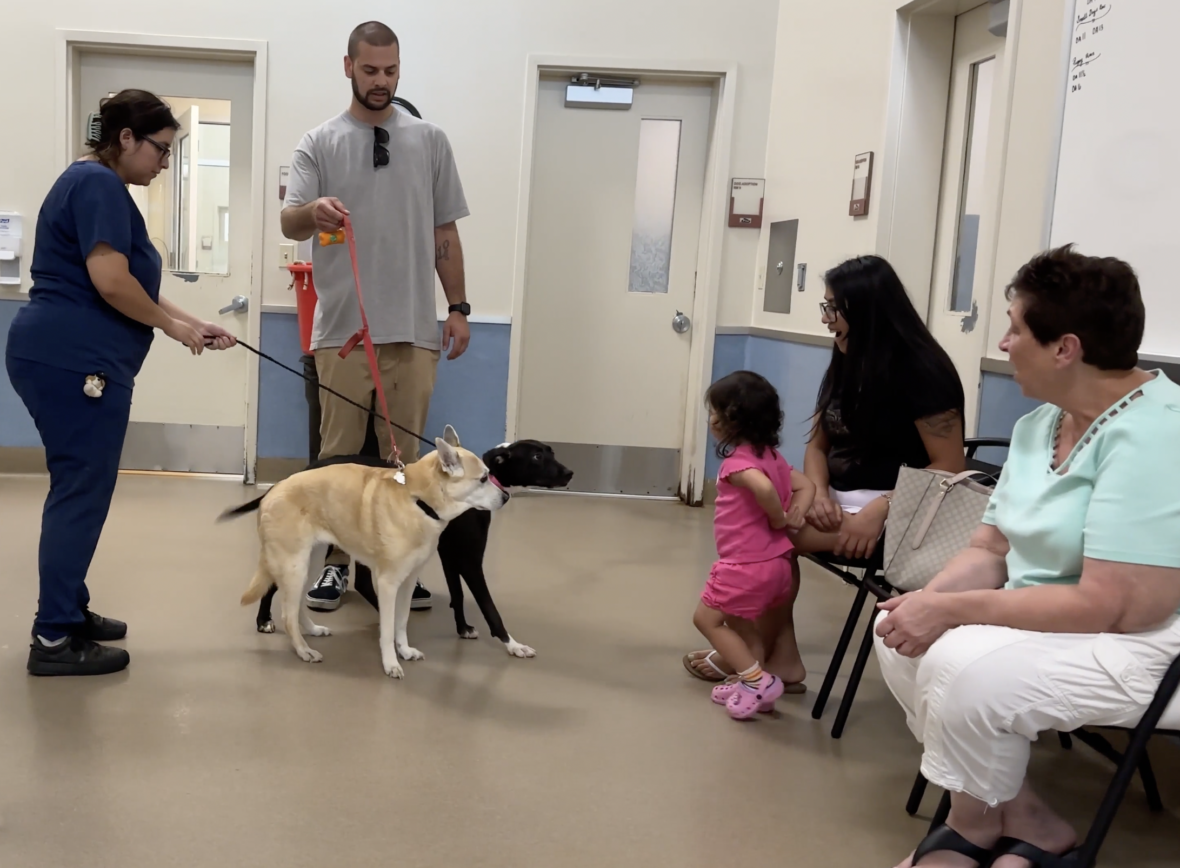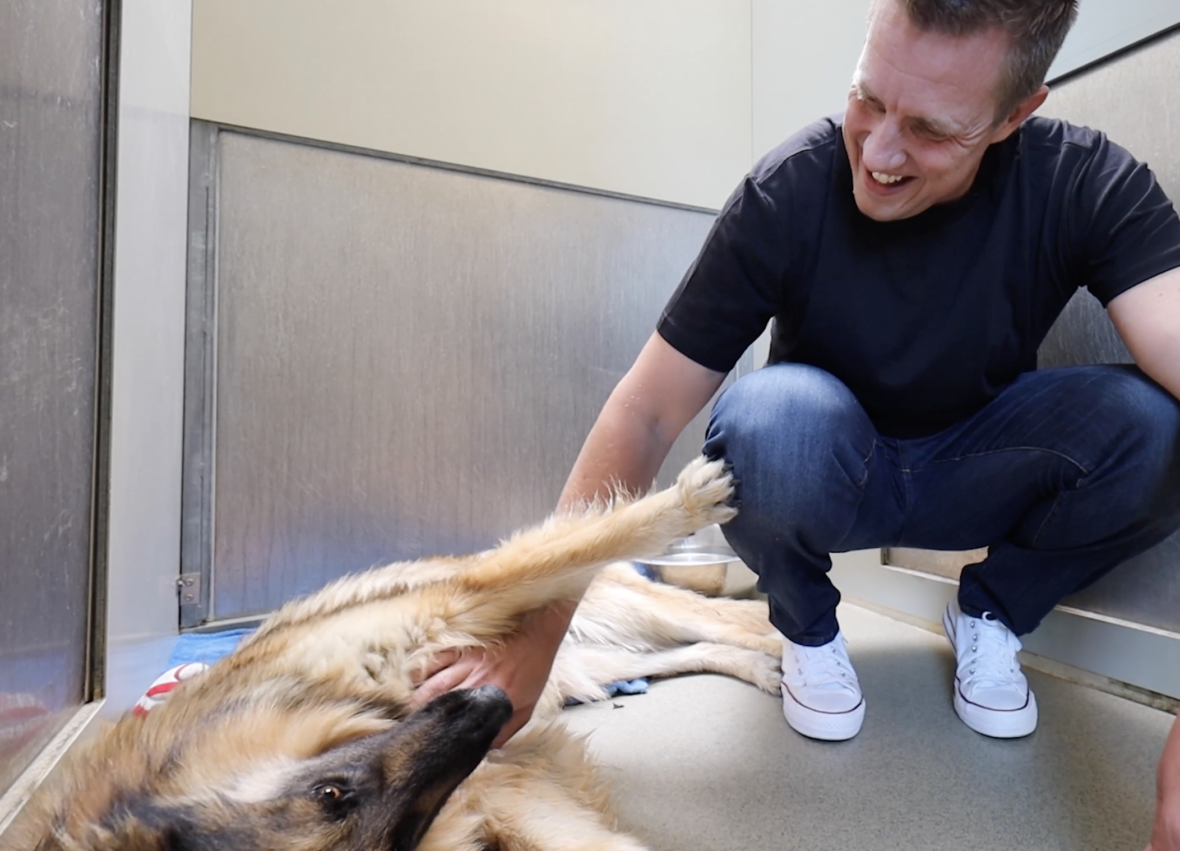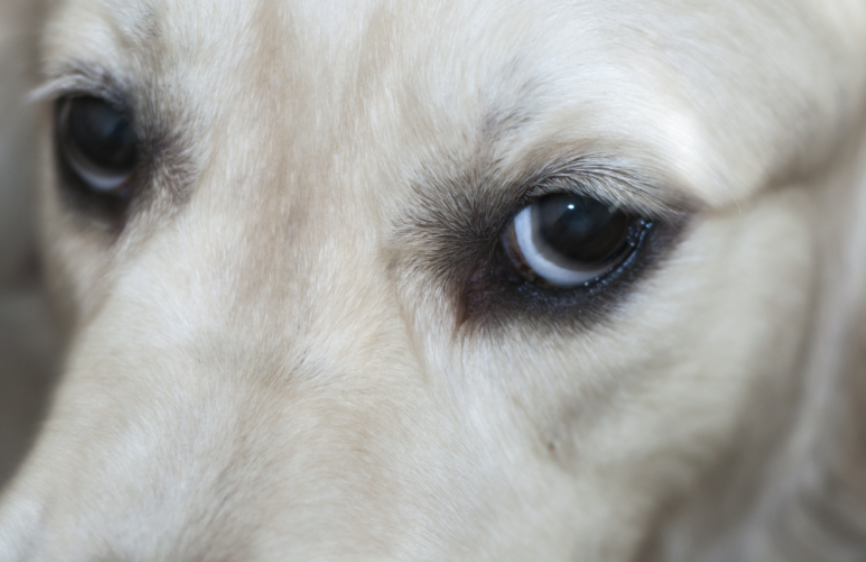Dog Meet and Greets: Navigating Polite Dog Behavior in Shelter Settings
If you are thinking of adopting a dog from a shelter or rescue, it’s important to understand that a dog’s behavior during a meet and greet can sometimes be misleading.

“Eagerness and excitement may seem like positive traits, but the world of dogs operates under a different set of social rules. Understanding boundaries is crucial to preventing tension and potential conflicts,” according to Alexis, Animal Care Specialist at Animal Friends of the Valleys in Wildomar, CA.
Eagerness and excitement may seem like positive traits, but the world of dogs operates under a different set of social rules.
Alexis, Animal Care Specialist
During a meet and greet between a potential adopter and a shelter dog, both humans and dogs need to be mindful of certain cues and signals. Here are some key points to consider when introducing two dogs:
- Neutral Territory: Choosing a neutral area for the meet and greet can help reduce territorial behaviors. In a shelter environment, dogs may become more territorial over their kennels or familiar spaces. A neutral space can help the dogs interact without feeling the need to establish ownership.
- Leash Etiquette: Keep both dogs on leashes initially and allow them to approach each other slowly. Avoid tense leash pulling, as it can create unnecessary stress and tension. Allow the dogs to circle and sniff each other while maintaining loose leashes. If the dogs seem friendly toward each other you can remove the leashes.
- “Dog Language”: Dogs communicate through body language, and understanding their cues is essential. Signs of discomfort or stress, such as stiff body posture, raised hackles, or growling, should be taken seriously. A dog that seems overly eager and rushes into another dog’s space without invitation may not be displaying polite behavior.
- Calming Signals: Look for calming signals, which are subtle ways dogs communicate to defuse tension. These can include lip licking, turning their head away, or yawning. If one dog is displaying calming signals, it’s important to respect their need for space.
- Positive Associations: Allow both dogs to have positive associations with the interaction. Keep the initial meeting brief and end it on a positive note with treats and praise. Avoid allowing any interactions to escalate into negative experiences.
- Professional Guidance: Shelter staff or volunteers are often experienced in dog behavior and can provide valuable insights during the meet and greet. Don’t hesitate to ask for their guidance and observations.
- Slow Introduction: If the initial interaction goes well, consider arranging for multiple controlled interactions over time. Gradually increasing the time and exposure can help the dogs build a positive rapport.
Understanding and respecting a dog’s boundaries during a meet and greet is key to a successful introduction. It’s important to remember that while eagerness and excitement are natural, a dog’s overall comfort and demeanor should guide the interaction. By fostering a positive and respectful interaction, potential adopters can make informed decisions and provide the best possible environment for their new furry friend.
Understanding A Dog’s Body Language
Understanding dog body language is essential for effective communication and safe interactions, especially during meet and greets or any social situation involving dogs. Here’s a list of key dog body language cues to be on the lookout for:
1. Tail Position:
- Wagging tail (loose and relaxed) – Usually indicates a friendly and relaxed mood.
- Tail held high and stiff – Can signal dominance or excitement, but could also indicate tension.
2. Ears:
- Relaxed and forward – Shows interest and engagement.
- Pulled back or flattened against the head – Sign of submission, fear, or anxiety.
3. Eyes:
- Soft gaze with slow blinking – Indicates relaxation and comfort.
- Staring with wide eyes – May be interpreted as a challenge or confrontation.
4. Mouth and Lips:
- Closed mouth – Generally relaxed and calm.
- Lip licking or tongue flicking – Often a sign of anxiety or appeasement.
- Snarling or showing teeth – Indicates fear, aggression, or discomfort.
5. Body Posture:
- Relaxed, loose body – Indicates a calm and friendly demeanor.
- Stiff, upright posture – May signal tension, assertiveness, or anxiety.
6. Hackles (hair along the back):
- Raised hackles – Indicates heightened arousal, which can be caused by excitement, fear, or aggression.
7. Yawning:
- Frequent yawning – Can be a sign of stress or an attempt to calm down.
8. Turning Away:
- A dog turning its head away from another dog or person – Indicates a desire to avoid conflict or confrontation.
9. Sniffing:
- Sniffing the ground or air – Dogs use scent to gather information and can do so to diffuse tension.
10. Play Bow:
- Front end lowered, rear end raised – A classic invitation to play, often accompanied by a wagging tail.
11. Freezing or Statue-like Stance:
- Complete stillness – May indicate the dog is unsure, anxious, or preparing for a reaction.
12. Piloerection (raised fur):
- Can be a sign of excitement, fear, or aggression.
13. Growling and Barking:
- Low growl – Can indicate discomfort, fear, or a warning.
- Continuous barking – May signal excitement, anxiety, or an attempt to communicate.
14. Bared Belly:

- Belly up and exposed – Can indicate submission or a desire to avoid conflict.
15. Whale Eye:

- When you can see the whites of a dog’s eyes – Often indicates fear or stress.
16. Tense Mouth and Jaw:

- A tightly closed mouth and tense jaw muscles – May indicate stress or potential aggression.
Remember, these cues should be considered in context, as dogs exhibit a range of behaviors based on their individual personalities and the situation they’re in. Observing and respecting these cues can help prevent misunderstandings and ensure safer interactions between dogs and humans or other dogs.
